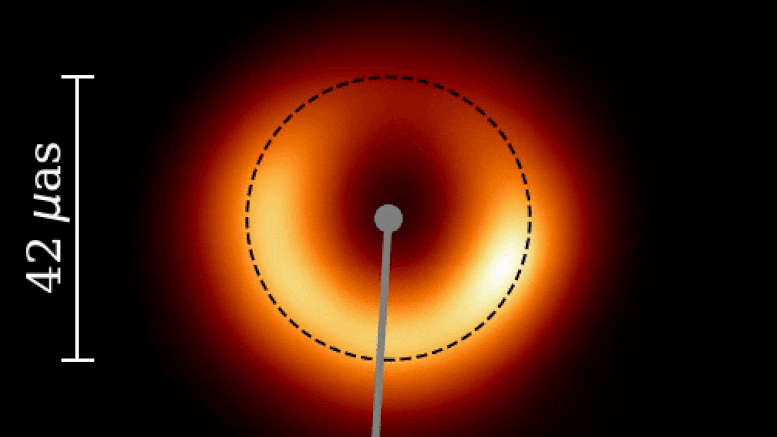
Snapshots of the M87* black hole appearance, obtained through imaging / geometric modeling, and the EHT array of telescopes in 2009-2017.
Analysis of the event horizon telescope observations from 2009-2017 reveals turbulent evolution of the M87 black hole image.
In 2019, the Event Horizon Telescope (EHT) Collaboration delivered the first image of a black hole, revealing M87*–the supermassive object in the center of the M87 galaxy.
The analysis reveals the behavior of the black hole image across multiple years, indicating persistence of the crescent-like shadow feature, but also variation of its orientation–the crescent appears to be wobbling.
“With the incredible angular resolution of the EHT we could observe a billiard game being played on the Moon and not lose track of the score!” said Maciek Wielgus, an astronomer at Center for Astrophysics | Harvard & Smithsonian, Black Hole Initiative Fellow, and lead author of the paper.
“Last year we saw an image of the shadow of a black hole, consisting of a bright crescent formed by hot plasma swirling around M87*, and a dark central part, where we expect the event horizon of the black hole to be,” said Wielgus.
The 2009-2013 observations consist of far less data than the ones performed in 2017, making it impossible to create an image.
Expanding the analysis to the 2009-2017 observations, scientists have shown that M87* adheres to theoretical expectations.
The black hole’s shadow diameter has remained consistent with the prediction of Einstein’s theory of general relativity for a black hole of 6.5 billion solar masses.
For the first time, they can get a glimpse of the dynamical structure of the accretion flow so close to the black hole’s event horizon, in extreme gravity conditions.
The gas falling onto a black hole heats up to billions of degrees, ionizes, and becomes turbulent in the presence of magnetic fields.
“When we first measured the size of M87* in 2009, we couldn’t have foreseen that it would give us the first glimpse of black hole dynamics.
We are already working on analyzing the data from 2018 observations, obtained with an additional telescope located in Greenland.
Reference: “Monitoring the Morphology of M87* in 2009-2017 with the Event Horizon Telescope” by Maciek Wielgus, Kazunori Akiyama, Lindy Blackburn, Chi-kwan Chan, Jason Dexter, Sheperd SE
The international collaboration of the Event Horizon Telescope announced the first-ever image of a black hole at the heart of the radio galaxy Messier 87 on April 10, 2019 by creating a virtual Earth-sized telescope.
The individual telescopes involved in the EHT collaboration are: the Atacama Large Millimeter/submillimeter Array (ALMA), the Atacama Pathfinder EXplorer (APEX), the Greenland Telescope (since 2018), the IRAM 30-meter Telescope, the IRAM NOEMA Observatory (expected 2021), the Kitt Peak Telescope (expected 2021), the James Clerk Maxwell Telescope (JCMT), the Large Millimeter Telescope (LMT), the Submillimeter Array (SMA), the Submillimeter Telescope (SMT), and the South Pole Telescope (SPT).
What Black hole M87 shown is the simultaneously result of Push and Pull Forces worked at this Black hole
September 23, 2020
September 23, 2020
September 23, 2020
September 23, 2020
September 23, 2020
September 23, 2020
September 22, 2020